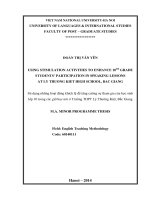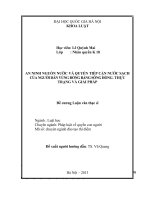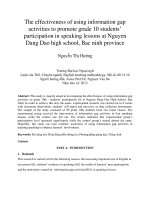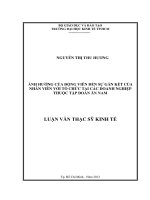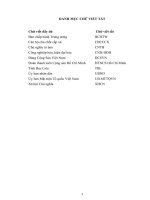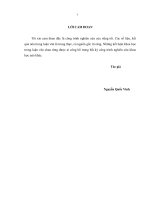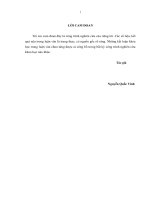(Luận văn thạc sĩ) an investigation into students’ participation in group work at luu nhan chu high school
Bạn đang xem bản rút gọn của tài liệu. Xem và tải ngay bản đầy đủ của tài liệu tại đây (745.76 KB, 65 trang )
VIETNAM NATIONAL UNIVERSITY, HANOI
UNIVERSITY OF LANGUAGES AND INTERNATIONAL STUDIES
FACULTY OF POST- GRADUATE STUDIES
-----------o0o------------
VƯƠNG THI ̣ THU HUYỀN
AN INVESTIGATION INTO STUDENTS’ PARTICIPATION IN
GROUP WORK AT LUU NHAN CHU HIGH SCHOOL
( NGHIÊN CỨU VỀ SỰ THAM GIA HOẠT ĐỘNG NHÓM CỦA HỌC
SINH TẠI TRƯỜNG THPT LƯU NHÂN CHÚ)
M.A. MINOR THESIS
Field : English Language Teaching Methodology
Code : 60.14.10
HaNoi, 2012
VIETNAM NATIONAL UNIVERSITY, HA NOI
UNIVERSITY OF FOREIGN LANGUAGES AND INTERNATIONAL
STUDIES
FACULTY OF POST- GRADUATE STUDIES
-----------o0o------------
VƯƠNG THỊ THU HUYỀN
AN INVESTIGATION INTO STUDENTS’ PARTICIPATION IN
GROUP WORK AT LUU NHAN CHU HIGH SCHOOL
( NGHIÊN CỨU VỀ SỰ THAM GIA HOẠT ĐỘNG NHÓM CỦA HỌC
SINH TẠI TRƯỜNG THPT LƯU NHÂN CHÚ)
M.A. MINOR THESIS
Field : English Language Teaching Methodology
Code : 60.14.10
Supervisor: ĐÀO THU TRANG, M.A
Ha Noi, 2012
LIST OF ABBREVIATIONS AND CHARTS
1. Abbreviations:
- CLT: Communicative Language Teaching
2. Charts:
- Chart 1: The frequency of teachers organizing group work in an English class
- Chart 2: The usual time group work often takes up over the total time of an
English lesson
- Chart 3: The benefits of group work
- Chart 4: Skills teachers often use with group work
- Chart 5: The ways teachers often prepare for group work classes
- Chart 6: Skill most suitable with group work
- Chart 7: Do students like taking part in group work in an English lesson?
- Chart 8: Students’ opinion about appropriate time for group work
- Chart 9: Students’ opinion about group work’s benefits
- Chart 10: The frequency of students taking part in group work
- Chart 11: Students’ opinions about difficulties when taking part in group work
- Chart 12: Students’ opinions about what their teachers should to make group
work successful
3. Tables:
- Table 1:Ways teachers often use to group students
- Table 2: Problems group work can cause
- Table 3: Factors affecting the success of group work most
- Table 4: What the teacher should do to make group work successful in an
English lesson.
- Table 5: Characteristics of the students participating in the language learning survey
- Table 6: Students’ opinions about suitable skills for group work
- Table 7: The ways students grouped by their teachers
- Table 8: Students’s preparation for group work
- Table 9: Students’ opinions about factors affecting the success of group work most
iv
TABLE OF CONTENTS
DECLARATION ..................................................................................................... i
ACKNOWLEDGEMENTS .................................................................................. ii
ABSTRACT ..........................................................................................................iii
LIST OF ABBREVIATIONS AND CHARTS .................................................... iv
Part A: INTRODUCTION .................................................................................... 1
1. Rationale. .................................................................................................... 1
2. Aims of the study. .......................................................................................... 2
3.Scope of the study. .......................................................................................... 2
4. Research questions of the study. ................................................................... 2
5. Methods of the study. .................................................................................... 3
6. Design of the study........................................................................................ 3
Part B: DEVELOPMENT..................................................................................... 5
Chapter 1: THEORETICAL BACKGROUND. .................................................. 5
1.1.
Communicative Language Teaching (CLT). ......................................... 5
1.1.1.Definitions of CLT. ............................................................................................... 5
1.1.2. Characteristics of CLT. ...................................................................................... 6
1.2.
Group work in teaching and learning English. ...................................... 7
1.2.1.
Definition of group work. .............................................................................. 7
1.2.2.
Advantages and disadvantages of group work. ......................................... 7
1.2.2.1 The advantages of group work. .................................................... 7
1.2.2.2 The disadvantages of group work. ................................................ 8
1.2.3. How to organize group work. ............................................................................ 9
1.2.3.1. Preparation for group work. ........................................................ 9
1.2.3.2. Steps in classroom. ....................................................................... 9
1.2.3.3. Steps of organizing group work. ................................................ 11
1.2.4.
Difficulties in organizing group work and suggested solutions ............. 12
1.2.4.1.Difficulties :.................................................................................. 13
1.2.4.2. Solutions : ................................................................................... 13
v
1.3.
Concepts of students’ participation in group work. ............................ 14
1.4. Summary. .................................................................................................. 15
Chapter 2: METHODOLOGY ........................................................................... 16
2.1. Context of the study. ................................................................................. 16
2.1.1. Description of English syllabus at Luu Nhan Chu High school. ................ 16
2.1.2. Description of the students at Luu Nhan Chu high school. ........................ 16
2.1.3. Description of the teachers at Luu Nhan Chu school. ................................. 17
2.2. Methodology and design of the study. ..................................................... 17
2.2.1. The participants. ................................................................................................ 17
2.2.2. Research questions............................................................................................. 18
2.2.3. Research methods. ............................................................................................. 18
2.2.4. Research instruments. ....................................................................................... 18
2.2.4.1. Survey questionnaire. ................................................................. 18
2.2.4.2. Classroom observation. .............................................................. 19
2.3. Presentation of statisical results. .............................................................. 19
2.3.1. Questionnaires. ................................................................................................... 19
2.3.2.
Classroom observation................................................................................. 33
Chapter 3: FINDINGS AND SUGGESTIONS. ................................................. 35
3.1. Findings. .................................................................................................... 35
3.1.1. What are the difficulties in organizing group work at Luu Nhan Chu high
school? 35
3.1.1.1. Difficulties from teachers. ........................................................... 35
3.1.1.2. Difficulties from students. ........................................................... 35
3.1.1.3. Other difficulties. ......................................................................... 36
3.1.2. How is group work organized in an English class at Luu Nhan Chu high
school? How do the students participate in group work? ......................................... 37
3.1.3. What are attitudes of the students at Luu Nhan Chu high school towards the
application of group work in teaching and learning English? ................................ 38
vi
3.1.4. How to organize group work in English class more effectively for improve
fours skills to students at Luu Nhan Chu high school?............................................ 38
3.2. Suggestions. ............................................................................................... 39
3.2.1. To teachers: ......................................................................................................... 39
3.2.2. To students:.......................................................................................................... 40
Part C: CONCLUSION. ..................................................................................... 41
1. Summary of the study ..................................................................................... 41
2. Limitations of the study. .................................................................................. 41
3. Suggestions for further study. ......................................................................... 42
REFERENCES: ................................................................................................... 43
APPENDIXES ................................................................................................ .. I
vii
Part A: INTRODUCTION
1. Rationale of the study
Nowadays, English has become one of the most popular languages in the world.
Because of its popularity, teaching and learning English is paid more attention
everywhere, especially Viet Nam. One of the reasons is that English is widely used in
many fields such as politics, business, international conference, education or just
everyday communication.
However, the results of the English learning are not very good. Vietnamese
teachers of English may not have applied the teaching method in effective ways. For
many years, we taught English in a traditional way in which teacher played the role of
the knowledge provider and the students were the passive knowledge receivers.
However, with the help of the communicative approach in language teaching, we are
now paying more attention to the role of students in the class. We begin to realize the
importance of students‟ interaction. We begin to teach English in a more natural way
by putting it in real communicative situations. The teachers are now trying to organize
communicative activities in English classes, among them, group work, key features of
learner- centered orientation- has received more emphasis because of a number of
advantages it brings about.
Group work creates more opportunities for students to work with each other by
exchanging their ideas and, therefore, learning so many things from their partners.
Participating in group work makes students confident and creative in learning English.
It also helps students overcome shyness.
Group work brings advantages not only for the learners but also for the teachers.
First of all, it saves time. Instead of asking individual student to practice a structure or
answer the questions, the teacher can divide the class into groups and make them do
the exercise at the same time.
1
Being a teacher of English at Luu Nhan Chu High School, the researcher is well
aware of the importance of using group work in English classes. However, like many
school teacher in Viet Nam, we still face with common problems coming from
teachers, students, classroom condition when organizing and using group work. This
led me to the choice of the study: “ An investigation into students’ participation in
group work at Luu Nhan Chu High school.” with the hope of investigating the ways
teachers organize group work and the students‟ participation into group work to find
out an effective way to improve four English skills for students at Luu Nhan Chu High
School. It is also hoped that this study may offer the teachers of English at Luu Nhan
Chu High School ways on how to use group work in teaching four English skills more
effectively.
2. Aims of the study
The aims of the study are:
- to investigate students‟ participation in group work and why they participated
in group work, the ways they did.
- to explore some strategies to increase students‟ participation in group work.
3.Scope of the study
As mentioned above, the study focuses on ways to organize and use group work
as well as the students‟ participation in group work at Luu Nhan Chu High school. The
researcher intends to draw a brief overview of group work in classes at Luu Nhan Chu
High School and to find out the ways to organize group work more effectively.
4. Research questions of the study
This study was aimed to answer the following research questions:
1. What are attitudes of the students at Luu Nhan Chu high school towards group work
in teaching and learning English?
2. How do the students participate in group work?
3. How is group work organized in an English class at Luu Nhan Chu High school?
2
How to organize group work in English class more effectively for students at Luu
Nhan Chu high school?
5. Methods of the study
To realize the aims of the study, both qualitative and quantitative methods are used.
-
By means of qualitative method: the author has to refer to different materials,
lectures, former researchers and relevant issues related to group work and
teaching and learning English to gain more knowledge of the subject matter and
to come to the final conclusion.
-
By means of quantitative method: all comments, remarks, recommendation
assumption and conclusion provided in the study based on the analysis of the
statistics from the survey questionnaires conducted with students and teachers of
Luu Nhan Chu High School.
In addition, the researcher also used class observations with the hope that two
methodologies supplemented each other so that the data could be more reliable.
6. Design of the study
This study consists of three parts:
Part A: Introduction: presents rationale, aims, scope, research questions, methods
and design of the study.
Part B: Developments: consists of three chapters.
Chapter 1: Theoretical background: reviews the theory of CLT, group work and
students‟ participation in group work.
Chapter 2: Methodology: provides an analysis on the current situation of using
group work in teaching and learning English at Luu Nhan Chu High school. Data
collection and analysis are also presented in this chapter.
Chapter 3: Findings and suggestions: focuses on how the teachers at Luu Nhan
Chu High School organized group work, difficulties faced by them and their students
3
in using these activities and some suggestions for the teachers to organize group work
and for the students to learn more effectively.
Part C: Conclusion: summarizes all the key issues as well as the limitations of the
study and makes suggestions for further research.
4
Part B: DEVELOPMENT
Chapter 1: THEORETICAL BACKGROUND
This chapter is devoted to building a conceptual framework for the research. It
consists of three sections. Section one deals with the issue of Communicative
Language Teaching (CLT) which is intended to be discussed in terms of CLT
definitions and its characteristics. Section two concerns some concepts of group work,
the benefits of group work, the ways to organize group work and difficulties when
organizing group work. Following section two, section three focuses on the concepts of
students‟ participation in group work.
1.1.
Communicative Language Teaching (CLT)
1.1.1.Definitions of CLT
The origins of Communicative Language Teaching (CLT) are to be found in the
changes in the British language teaching tradition dating from the late 1960s.
The communicative approach in language teaching starts from a theory of
language as communication. The goal of language teaching is to develop what Hymes
(1972) referred to as "communicative competence." Hymes defines “communicative
competence” as “ what a speaker needs to know in order to be communicatively
competent in a speech community”.
Another theorist frequently cited for his views on the communicative nature of
language is Henry Widdowson. In his book Teaching Language as Communication
(1978),Widdowson presented a view of the relationship between linguistic systems
and their communicative values in text and discourse. He focused on the
communicative acts underlying the ability to use language for different purposes.
Littlewood (1984) consideres an alternative learning theory that he also see as
compatible with CLT-a skill-learning model of learning. According to this theory, the
acquisition of communicative competence in a language is an example of skill
5
development. This involves both a cognitive and a behavioral aspect.
The cognitive aspect involves the internalisation of plans
for creating
appropriate behaviour. For language use, these plans derive mainly from the language
system- they include grammatical rules, procedures for selecting vocabulary,and social
conventions governing speech.
The behavioural aspect involves the automation of these plans so that they can
be converted into fluent performance in real time. This occurs mainly through practice
in converting plans into performance.
(Littiewood 1984: 74). This theory thus
encourages an emphasis on practice as a way of developing communicative skills
(Richards 1986).
With CLT, students are given the language they need to deal with real
situations. Less importance is placed on producing grammatically correct English,
while more importance is placed on dealing effectively with the situation.
In other words, CLT deals with communicative competence - the ability to
communicate - rather than grammatical accuracy.
1.1.2. Characteristics of CLT
It is no doubt that the characteristics of CLT, if precisely understood, may help
teachers translate the theory of CLT into classroom reality and make their classroom “
communicative”.
David Nunan (1991:279) lists five basic characteristics of Communicative Language
Teaching:
- An emphasis on learning to communicate through interaction in the target language.
- The introduction of authentic texts into the learning situation.
- The provision of opportunities for learners to focus, not only on language but
also on the Learning Management process.
- An enhancement of the learner‟s own personal experiences as important
contributing elements to classroom learning.
6
- An attempt to link classroom language learning with language activities
outside the classroom.
According to CLT, group work activities are considered to be the most common
practices in a language classroom, in which students are allowed to interact with each
other and then will be able to communicate in the target language.
1.2.
Group work in teaching and learning English
1.2.1. Definition of group work
There are many definitions about group work:
Adrian Doff ( 1988: 137) defines group work as a process that “ the teacher
divides the class into small groups to work together ( usually four or five students in
each group), all the groups work at the same time”.
According to Richards ( 1983: 189), group work is an essential activity because
the kind of interactions produced in group activities has been shown to be
quantitatively as well as qualitatively different from that which goes on in the teacherdominated lessons.
Clearly, group work is a co- operative activity, during which students share aims
and responsibilities, moreover, they have chance for greater independence as they take
some of their own learning decisions, without the teacher controlling every move. And
they can work without the pressure of the whole class listening to what they are doing.
They learn to listen to different opinions. They feel free to experiment and use the
language, and the most important thing is they have many chances to interact with each other.
1.2.2. Advantages and disadvantages of group work
1.2.2.1 The advantages of group work
According to Hubert Skrzynski, group work plays an important role in teaching
and learning Engish because of several advantages as follows:
- Increase in the amount of student practice: When students work in group they have
more chances to practise. Group work drammatically increases students talking time
7
and students‟ participation.
- Increase in the students’ confidence: Students who are shy of speaking in front of
the whole class, or to the teacher, often find it much easier to express themselves in
front of a small group. For teachers, because there are more than two people in a group,
there is a greater chance of different opinions and varied contributions than in working
individually or in pairs, it frees the teacher from her traditional role of “ an expert who
always lectures” and allows her to wander freely round the class, leading and
encouraging discussion, giving help where needed. ( Harmer, 1999: 116).
- Mutual help: Group work encourages students to share ideas and knowledge. In a
class, there are always weak and strong students, so working in groups, students can
learn from each other a lot. It recognizes the old maxims that “ two heads are better
than one”, thus promoting learner cooperation. ( Adrian Doff, 1988: 144).
1.2.2.2 The disadvantages of group work
Using group work also has some disadvantages. Belows are some common problems:
- Native language interference: One of the disadvantages is that students often speak
in their native language. If the class is really big with many students, it is very difficult
for the teacher to listen all groups at the same time. However, the teacher can change
this situation by establishing certain rules at the beginning of the school year.
- Noisiness: Clearly, working in group in a large class will be noisy. The teachers have
more trouble than the learners have. Usually the students themselves are not disturbed
by the noise as much as the teacher is.
- Mistake correction: Another problem is incorrectness. While students work in group,
the teacher cannot control all the language used, thus, cannot correct every mistake
students make.
To sum up, in spite of several disadvantages, the advantages of group work far
outweighed the disadvantages. Instead of being dependent on the teacher, students get
used to helping and learning from each other in a non- threatening environment.
8
Meanwhile, the teacher is left free to discreetly monitor progress and give help, advice
and encouragement where and when it is needed.
1.2.3. How to organize group work
1.2.3.1. Preparation for group work
In order to prepare for group work, according to Felisa Tibbits, the teacher
needs to do the following:
-
Select the activity.
-
Prepare materials.
-
Anticipate the size and the selection of groups.
-
Anticipate how students will be organized within the groups (tasks and roles).
-
Consider the timing of the group.
-
Consider how the small group will be shared with the entire class and linked
with the overall curriculum.
1.2.3.2. Steps in classroom
* Selection of activity
An activity that is best suited for group work may meet the following criteria:
-
The activity has multiple tasks that can be shared among group members or a
single task, such as generating ideas, that benefit from the participation of all
individuals within a group.
-
The activity involves problem solving and discussion
-
Examples of activities that may be suited for group work are investigations of
materials (newspapers, scientific specimens) and development of ideas or
arguments
* Preparation of materials
The teacher will need to personally collect, or organize students to collect,
physical specimens for investigation. For example, if the teacher anticipates doing a
lesson on the role of the media, she or he might ask the students to bring in to class
9
newspapers and magazines. There should be materials sufficient for each group.
* Size and selection of group
Group size normally ranges between 3-5 students. Group size can sometimes go
larger although groups larger than 8 do not ensure that everyone will participate.
Since groups often report their work back to the whole class, teachers also take
into account the total number of groups within the class.
Group membership can be determined in different ways. A random selection
might be done by “counting off” with students (go around the room systematically
having students count 1, 2, 3, etc., with each numbers representing a group) or
selecting groups on the basis of birth date.
In a non random selection, groups will be selected based on the teachers‟ prior
knowledge. Usually, groups are selected to maximize diversity within the group, since
diversity enhances learning. Such groups often have a balance of girls and boys, and
students with differing ability levels. Teachers can also use their best judgement about
personality mixes that would enhance the work of the group.
Sometimes groups are organized only for one activity. Other times, teachers use
the same small groups for a series of activities, so that students get used to working
with one another.
If the tables and chairs cannot be moved for group work, then students can form
groups by turning around in seats to face their partners behind.
* Organization of students within the group
A laissez- faire approach to group work would be that the teacher gives a
general assignment to the group- like organizing a research project on „qualities of
good leaders‟- and the students are left to organize themselves.
A highly structured approach would be that the teacher assigns a specific role to
each group member. A semi- structured approach might be that the teacher recommend
certain roles, but leaves it to the group to assign roles.
10
A more structured approach, with rotation of tasks within a group, is often used
with younger children. A less structured approach can be used with students with
experience in group work or for simple tasks that do not require that students take on
different roles.
* Group work timing
The teacher should anticipate student questions about timing, the task results,
sharing with the whole group, and so on. After giving clear instructions to the students,
the teacher should be available to answer questions, but not interfere with the groups‟ activities.
It is common in many classrooms that a small group activity constitutes 20
minutes of a 40 minute- period, with 10 minutes allowed for sharing small group work
with the whole class.
* Group work sharing with the whole class
Usually the results of the small group work are shared with the class. This
sharing can be oral (reporting out), visual (written or graphic representation), or both.
It is highly interesting to contrast the results of group work.
1.2.3.3. Steps of organizing group work
Harmer, J devides it in to 3 steps : before activities, during activities and after activities.
* Before : The teacher should make students feel enthusiastic about what they are
going to do. They need to understand what they are going to do, and when they have to
finish the task they are going to get involved in.
Sometimes teacher‟s instructions will involve a demonstration- when, for
example, students are going to use a new information- gap activity or use card. On
other occasions, where an activity is familiar, teacher may simply give them an
instruction to practise the language they are to study in groups, or to use their
dictionaries to find specific bits of information.
The important thing about instructions is that the students should understand and
agree on what the task is. To check that they do teacher may ask them to repeat the
11
instructions, or, in monolingual classes, to translate them in to their first language.
* During : While students are working in groups the teachers have a number of
options. They could, for instance, stand at their convenience in the classroom and keep
an eye on what is happening, noting who appears to be stuck, disengaged, or about to
finish. In this position teacher can „tune in‟ to a particular group from some distance
away. The teachers can then decide whether to go over and help that group.
An alternative procedure is to go round the class watching and listening to
specific groups. The teacher can stay (with their agreement) for a period of time and
then intervene if we think it is appropriate or necessary, always bearing in mind the
difference between accuracy and fluency work
When students are working in groups the teacher has an ideal opportunity to
work with individual students whom they feel would benefit from their teachers‟
attention. They also have a great chance to act as observer, picking up information
about students‟ progress.
* After : When groups stop working together the teacher needs to organise feedback.
The teacher wants to let them discuss what occurred during the group session and,
where necessary, add their own assessments and make corrections.
Where groupwork has formed part of a practice session, our feedback may take the
form of having a few groups quickly demonstrate the language they have been using.
The teachers can then correct it, if and when necessary, and this procedure will give
both those students and the rest of the class good information for future learning and action.
Finally, it is vital to remember that constructive feedback on the content of
student work can greatly enhance students‟ future motivation. The feedback the
teachers give on language mistakes is only one part of that process.
1.2.4. Difficulties in organizing group work and suggested solutions
When teachers organize groupwork, they encounter some difficulties.
12
1.2.4.1.Difficulties :
According to Andy Hoodith- Saitama University, there are three main
difficulties while working in pair and group.
* Space : The furniture in the class is fixed, the teachers and students can not change
or have no time to do it. Sometimes the class is too crowded (with more than 50
students in a small room), there is no space for them to move. Thus group work proves
to be difficult to organize in such situation.
* Instruction : It is neccesary for students to know what the teacher wants them to do.
This sounds obvious and easy, but in some case, some students don‟t know exactly
what they have to do. Some teachers try to give instructions in the target language, and,
ironically it sometimes appears that understanding the instructions in the target
language is much more difficult than doing the task.
* Activity Types : Group work is fine in theory, but what type of activity to do with it
is a problem. Some group members may sit doing nothing if teacher asks a group of
four or five to work with a small dialogue. And problem solving activities seem to be
difficult for groups when one of them or none of them has no idea about the problem.
1.2.4.2. Solutions :
Along with the difficulties, some solutions have been suggested by Andy Hoodith.
If the furniture in the class is fixed and it is impossible to change the classroom,
then the teacher should plan more carefully, and try to create gaps between the groups
and circles of interaction.
Drawing a plan of the room and visualizing the arrangements will help to
achieve this.
For difficulties in giving instructions, Andy Hoodith considers that students
should be given instructions in their mother tongue. It‟s better to be strict, then ease up,
than to allow students too much leeway to use their mother tongue in the first few
lessons and then try to stop them overusing it. One method is to explain briefly in
13
English, then if necessary supply written instructions in their mother tongue. If students
are still not clear, about what to do, then the written instructions probably weren‟t very
good ! The teacher can then allow a couple of minutes for them to clarify the
instructions for each other in mother tongue, and one example can be made to make
students completely understand the instructions.
1.3.
Concepts of students’ participation in group work
Students‟ participation can be identified in terms of three kinds of interaction :
students to their teacher, students to students, and students to materials.
The interaction between students and their teacher includes care, contact, cooperation between them in the class. Students who have a good interaction with their
teacher always participate in the class discussion, support each other and act as the
teacher‟s requirement. Thus, participation not only means attending the class regularly
and on time but also taking part in the lesson actively or showing desire or being
active. Students become self- centered in the class activities.
The interaction between students and students is set up through their discussion
in small groups. They work together, help each other, and learn from each other. A
good interaction involves their co- operation and contribution to the task given.
Students feel pleasant and comfortable when they work together, then they will do their
best to complete the task.
Students‟ participation also includes the interaction between students and
materials. Clearly, students will be active and pay more attention to the lesson if they
are interested in the material or the task given. In other words, good and interesting
materials can get students involved in the lesson. Students will find it difficult to
participate in the class activities if they do not understand the tasks or feel bored with
them. ( Ellis, 1994 : 178).
In short, students‟ participation is concerned with their activeness in the lesson,
their success in completing the class activities and their attention to what is happening
in the class.
14
1.4. Summary
In conclusion, this chapter covered the theories related to CLT, classroom work
arrangements including group work, advantages, disadvantages of group work, the way
how to organize group work, difficulties when organzing group work, and students‟
participation in group work.
To increase the students‟ participation in classroom activities, especially in
group work, the teacher should encourage students‟ roles in learning activities. The
next chapter will present all the information concerning the study : the context of the
study at Luu Nhan Chu High School including English syllabus, the students and the
teachers, the methodology of the study, the participants, research questions, research
instruments and presentation of statistical results.
15
Chapter 2: METHODOLOGY
2.1. Context of the study
2.1.1. Description of English syllabus at Luu Nhan Chu High school
Luu Nhan Chu High School is a newly established school in Dai Tu district,
Thai Nguyen province. We have 30 classes, 10 classes for each course. There are three
levels of English: English 10, 11 and English 12. Because English is one of the main
subjects and it is now a compulsory one in Luu Nhan Chu High school, students have
English lessons during the first term and second term of the school year.
The textbook chosen for students at Luu Nhan Chu High school is English 10,
11 and 12 by Hoang Van Van, Hoang Thi Xuan Hoa, Do Tuan Minh, Nguyen Thu
Phuong, Nguyen Quoc Tuan, Nha Xuat Ban Giao Duc. In each textbook, there are 16
units which consist of 5 parts: Reading, Speaking, Listening, Writing and Language
Focus. After each four unit, there is a test with the aim of checking students basic
knowledge of English and practice four skills. This is a new textbook with many
pictures and suitable for applying Communicative Language Teaching. By using this
textbook, students‟ communicative competence can be developed and they can know
more real things from daily life. Students are required to work in group to practise
English everyday. Moreover, they have chances to listen to native speakers from the tapes.
At the end of the course, students have basic knowledge of English, especially
grammar, also they can communicate with foreigners by using many different types of
conversations.
2.1.2. Description of the students at Luu Nhan Chu high school
To be 10th form students at Luu Nhan Chu High School, all students have to
take an entrance exam, like many other students in Viet Nam. They are all from
different, poor countryside in Dai Tu District. They have learnt English for four years
at secondary school. However, their English language proficiency is very low. And
16
their levels are not the same in general. At Luu Nhan Chu High School, students have
to spend three years to learn Engish to develop their four skills in order to get general
certificate of education. Like other main subjects, English is taught three periods and
one optional period per week. Students have four fifteen minute tests, two forty- five
minute tests for each term and two final examinations.
2.1.3. Description of the teachers at Luu Nhan Chu school
If students are the most important factor in the learning process, teachers are the
most important factor in the teaching process. In Luu Nhan Chu High School, there are
9 teachers of English language aged from 25 to 31. All of them are very young and
there is only one teacher has ever been to a foreign country. Of 9 teachers, 7 have been
trained at Thai Nguyen college of Education, one has been trained from Hue university
and one has been trained at Ha Noi University of foreign study. There are only two
teachers are learning to get M.A degree. Because of the young age and lacking of
experience, all teachers at Luu Nhan Chu High School find difficult to be familiar with
new teaching method in which the use of procedures that develop the four language
skills through working in groups is problem- solving tasks.
2.2. Methodology and design of the study
2.2.1. The participants
There are 120 students and 8 teachers at Luu Nhan Chu High School took part
in this study. The researcher chose these 120 students from 10th form, 11th form and
12th form randomly. Of all 120 students, there are 70 female and 50 male at the age
from 16 to 18. They come from different places in Dai Tu District so they may have
different background and living condition. All of them have learnt English for at least 4
years at their secondary school. However, in term of knowledge and learning
environment, they are quite different. 8 teachers are very young, aged from 25 to 31.
A survey is conducted among students and teachers at Luu Nhan Chu High
School to find out the information about the current situation of class activities: group
17
work. The survey questionaire includes information about group work at school ( see
Appendix 1 and 2). The results of the survey is illustrated in the next part. The
reseacher observed 8 classes and then analyze the data collected from the questionaires
and class observation sheets to find information to answer the research questions. After
analyzing the data, some conclusion must be drawn and some suggestions for further
research must be made, too.
2.2.2. Research questions
In order to get information about group work and to find out the fact how group
work is used at Luu Nhan Chu High School and how effectively it is used, the
researcher raised the following research questions:
1. How is group work organized in an English class at Luu Nhan Chu High school?
2. What are attitudes of the students at Luu Nhan Chu high school towards the
application of group work in teaching and learning English?
3. How do the students participate in group work?
4. How to organize group work in English class more effectively for improve
fours skills to students at Luu Nhan Chu high school?
2.2.3. Research methods
In order to get the needed information the researcher uses two following
research methods:
1. Questionaires
2. Class observation
2.2.4. Research instruments
2.2.4.1. Survey questionnaire
The survey questionnaire is considered as one of the most effective instruments
for collecting data in social science. Because of the advantages of questionnaire such
as: less pressure on respondents than interview and straight forward analysis of answer
, this study used the questionaire as the main source to fullfill its aims. There are two
18
types of questionnaires: one for teachers and one for students. Each of them has ten
questions. The questionnaires are mainly used for exploiting teachers‟ and students‟
knowledge, experience, their attitude toward group work.
2.2.4.2. Classroom observation
Besides questionnaires, classroom observation is another tool to collect more
information about the reality of the application of group work activities in teaching and
learning English. Observation is carried out in different classes. The researcher has to
design the Class Observation sheet before observing classes. The classes observed
must be from grade 10 to 12 and with all 8 teachers of English in Luu Nhan Chu High
School and they should not be prepared especially for being observed. They must be
done in normal way. And the researcher must not do anything to interfere the class
while observing.
2.3. Presentation of statisical results
2.3.1. Questionnaires
Questionnaires were taken in Luu Nhan Chu High School from August 5th to
August 10th. The questionnaires consist of ten questions and after each question there
are options for teachers and students to choose, in some questions more than one
options can be chosen. The questionnaire was aimed at exploring the understanding,
the attitude and the way the teachers used group work in their language classes. The
questionnaires were delivered and collected before the classes were observed.
Here are the results of the questionnaires:
* The results of language teaching survey questionnaires
The results of the language teaching survey
This questionnaire helps the reseacher know the attitude, the knowledge and the
understanding of group work of the teachers at Luu Nhan Chu High School.
19
